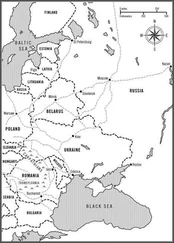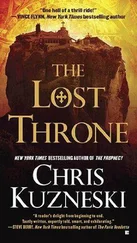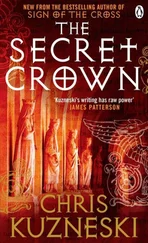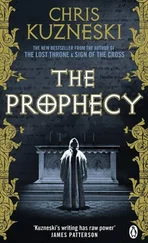Chris Kuzneski - Sign of the Cross
Здесь есть возможность читать онлайн «Chris Kuzneski - Sign of the Cross» весь текст электронной книги совершенно бесплатно (целиком полную версию без сокращений). В некоторых случаях можно слушать аудио, скачать через торрент в формате fb2 и присутствует краткое содержание. Жанр: Фантастика и фэнтези, на английском языке. Описание произведения, (предисловие) а так же отзывы посетителей доступны на портале библиотеки ЛибКат.
- Название:Sign of the Cross
- Автор:
- Жанр:
- Год:неизвестен
- ISBN:нет данных
- Рейтинг книги:3 / 5. Голосов: 1
-
Избранное:Добавить в избранное
- Отзывы:
-
Ваша оценка:
- 60
- 1
- 2
- 3
- 4
- 5
Sign of the Cross: краткое содержание, описание и аннотация
Предлагаем к чтению аннотацию, описание, краткое содержание или предисловие (зависит от того, что написал сам автор книги «Sign of the Cross»). Если вы не нашли необходимую информацию о книге — напишите в комментариях, мы постараемся отыскать её.
Sign of the Cross — читать онлайн бесплатно полную книгу (весь текст) целиком
Ниже представлен текст книги, разбитый по страницам. Система сохранения места последней прочитанной страницы, позволяет с удобством читать онлайн бесплатно книгу «Sign of the Cross», без необходимости каждый раз заново искать на чём Вы остановились. Поставьте закладку, и сможете в любой момент перейти на страницу, на которой закончили чтение.
Интервал:
Закладка:
They’d spent the past few days together burrowing into the 900-foot plateau that lifted Orvieto high above the vineyards of the Paglia Valley, a location so impenetrable that it was used as a safe haven by the popes of the Middle Ages. Papal documents prove that the Italian popes transformed Orvieto into the vacation Vatican , their home away from home during the most tumultuous era in the history of the Roman Catholic Church. Sadly, papal scribes were banned from describing any specifics for fear that their descriptions could be used by their enemies to plan an attack. Still, that didn’t stop rumors from spreading.
According to legend there was supposed to be a city built underneath the city — the Catacombs of Orvieto — which was used to store the Church’s most important documents and protect its most precious artifacts. Most experts dismissed the Catacombs as a fairy tale, the creation of a drunk monk from the fourteenth century. But not Dr Boyd. Not only did he believe in their existence, he used all of his free time to search for them.
‘ Professore? When I was little, my father used to speak of the Catacombs, though he never talked about them in real terms. He always considered them to be like Atlantis.’ Pelati took a deep breath and brushed the hair out of her eyes, something she did when she was nervous. ‘Well, sir, I was wondering, why are you sure that the Catacombs exist?’
He held her gaze for several seconds, then eased the tension with a half smile. ‘Trust me, my dear, you aren’t the first person to question me. I mean, who in their right mind would waste their time searching for the Catacombs? I might as well be fishing for the Loch Ness Monster.’
She laughed. ‘Just so you know, it’s probably cooler near Loch Ness.’
‘And just so you know, I’m not the least bit crazy.’
‘I never said that you were.’
‘But you’ve considered it. You’d be crazy if you didn’t.’
She brushed the hair out of her eyes again. ‘There’s a very fine line between genius and insanity, and I’ve never seen you cross that line… Of course, you are rather elusive. You still haven’t told me about the Catacombs yet.’
‘Ah, yes, the Catacombs. Tell me, my dear, what do you know about the Roman Empire?’
‘The Roman Empire?’ she asked, puzzled. ‘I know quite a bit, I guess.’
Without saying another word, he handed her a series of documents from his fanny pack, then took a seat in the shadows of the rear wall, waiting for the reaction that he knew would come. ‘Santa Maria!’ she shrieked. ‘This is Roman!’
‘Hence my question about the Empire. I thought I made that rather clear?’
Pelati shook her head, then returned her attention to the documents. At first glance they seemed to illustrate an elaborate system of tunnels that were hidden underneath the streets of Orvieto, yet it wasn’t the maps or the illustrations that perplexed her but rather the language itself. The document was handwritten in a form of Latin that she was unable to translate.
‘Is this authentic?’ she demanded.
‘That depends on your perspective. You’re holding a photocopy of a scroll that I found in England. The photocopy is obviously fake. The original is quite real.’
‘In England ? You found the scroll in England ?’
‘Why is that so surprising? Julius Caesar spent some time there. So did Emperor Claudius.’
‘But what does that have to do with the Catacombs? I mean, the popes came to Orvieto a thousand years after the fall of Rome. How could this be related?’
Pelati knew that Pope Gregory XI died of natural causes in 1378, leaving a vacancy that was filled by Pope Urban VI. Many cardinals claimed that he was improperly selected, and they demanded a second election. When the next outcome differed, the Catholic Church severed, splitting into two factions, with each supporting a different pope. Italy, Germany, and most of northern Europe recognized Urban VI, while France and Spain supported Clement VII.
This rivalry, known as the Great Schism of the West, divided Catholicism for almost forty years and in the process put the papal courts in danger — not only from outsiders but from each other. For that reason, the Italian popes spent much of their time in Orvieto, which was virtually impervious to attack because of its location on the plateau. And it was there, in the depths of the tufa stone, that the legendary Catacombs were supposedly built.
Boyd smiled at the confused look on his pupil’s face. Refusing to make it easy on her, he said, ‘Tell me, my dear, have you ever been to the Roman ruins in Bath?’
She growled in frustration. ‘No, sir. Why do you ask?’
‘Ah,’ he sighed, remembering the quaint town on the River Avon. ‘There you are in the middle of the English countryside, yet you’re surrounded by relics from ancient Rome. It seems so surreal. Do you know what the most amazing thing is? The baths still work. The warm springs still bubble up from the ground, and the architecture still stands proud. Ancient pillars rising to the heavens from the magical waters below. It is somewhat amazing, if you think about it.’
Confused by his tale, Pelati grimaced. ‘Not to be rude, but what are you implying?’
‘Think about it, my dear. The popes of the 1300s used the Catacombs for protection. However, that doesn’t mean that they built them. The ancient Romans were well ahead of their time. Correct? I figure if they were able to build bathhouses that still work two thousand years later, then they certainly could’ve built some tunnels that were still standing seven hundred years ago.’
‘Wait! So that’s why there were no records of their construction. They were already in place when the pope came to town?’
He nodded, pointing to the documents in her hand. ‘When I found the original scroll, I assumed it was a hoax. I mean, how could it possibly be real? Then I had it tested, and the results were conclusive. The scroll predated the Schism by more than a thousand years, proving once and for all that the Catacombs actually existed. Furthermore, they weren’t built for the popes of the Middle Ages. They were built by the ancient Romans.’
‘A date,’ she demanded. ‘Do you have an exact date for the scroll?’
‘As you know, carbon dating isn’t that specific. The best I could come up with was an era.’ Boyd took a sip of water, trying to prolong the suspense. ‘According to my tests, the Catacombs of Orvieto were built during the life of Christ.’
4
Nearly 300,000 tourists flock to Kronborg Castle every year, but none of them had ever seen this before. And those that saw it wished they hadn’t.
By the time Erik Jansen was discovered, his torso was grayish white, and his legs were light purple, caused by postmortem lividity. Birds dined on his flesh like a country buffet.
A group of students spotted Jansen across the courtyard and assumed that he was a historical exhibit. So they walked closer, marveling at all the wonderful little details that made him seem lifelike: the color of his flesh, the horror on his face, the texture of his sandy-brown hair as it blew in the wind.
They crowded around him, begging to have their picture taken with the display. That is until one of them felt a drop. A single drop. That was all it took. One drop of blood and chaos erupted. Kids were wailing. Parents were screaming. Teachers scurried for help.
The local police were called to the scene but were in over their heads. They were used to car accidents and petty crimes, not murders. Certainly nothing of this magnitude. Yet that was to be expected in a quiet place like Helsingør. It sat on the northwestern coast of Sjaelland Island across the øresund from Hälsingborg, Sweden, away from the city life of Copenhagen. The last time anyone was brutally killed here was back in 1944, and that had been done by the Nazis.
Читать дальшеИнтервал:
Закладка:
Похожие книги на «Sign of the Cross»
Представляем Вашему вниманию похожие книги на «Sign of the Cross» списком для выбора. Мы отобрали схожую по названию и смыслу литературу в надежде предоставить читателям больше вариантов отыскать новые, интересные, ещё непрочитанные произведения.
Обсуждение, отзывы о книге «Sign of the Cross» и просто собственные мнения читателей. Оставьте ваши комментарии, напишите, что Вы думаете о произведении, его смысле или главных героях. Укажите что конкретно понравилось, а что нет, и почему Вы так считаете.












